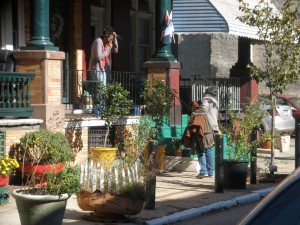
With East Parkside known widely for attractions like the Mann Center, the Please Touch Museum and Fairmount Park, the small side streets in this community are typically overlooked.
The 4200 block of Viola Street proves to be a community of its own in East Parkside. Surrounded by the famed attractions, residents fight to improve the quality of life on their historical block.

“The houses on the north side of Viola Street are on the [national] Historic Registry. They were built in the late 1800s,” longtime Viola Street resident Michael Burch said.
“To infill the empty lots that were created in the ’80s, when houses were being torn down, the houses would have to be of like aesthetic structure and that costs money.”
East Parkside is currently in a period of revitalization. While many residents feel city officials are focused too much on building tourist attractions in their area, residents maintain a sense of urgency for building collaborations with officials to redevelop their community as well.
“We have the Please Touch Museum, the Mann Center – I don’t see why Viola Street is essentially getting ignored,” Jean Allen said.
“We’ve endured a lot on Viola Street and when development comes we want to be here,” Viola Street Resident’s Association President Lorraine Gomez said.
Burch now lives in the home he grew up in with his wife Yvette. He moved away and has returned back to his childhood neighborhood.
“There wasn’t much thought that went into moving back to Viola Street. The park is right there and who doesn’t want to live right next to the park?” Burch said.
“When his mom was alive she and I would say that Mike left all of his toys on Viola Street, like his bike,” Yvette Burch said.
The homes lining Viola Street have an Old World feel to them. Some of those structures have been either abandoned, torn down or converted into apartments. Block residents are working with the homeowners of the abandoned houses to try to maintain them as single family homes.
“It’s weird to have these houses that were once single homes converted to apartments, you can feel it,” Joyce Williams said. “I could name all the families who lived in each of these houses all the way down the street.”
“This isn’t a neighborhood. This street is a community. And when you put these apartments in it changes the vibe of the community, it changes the family orientation,” Valerie Booker said.

The residents of Viola Street are passionate about the upkeep and safety of their block.
Residents want their block to reflect their caring and proactive nature and instill this by holding frequent block clean ups, painting abandoned houses to give them some type of curb appeal, consistently contacting city officials to fix their sidewalks and brainstorming ways to combat the amount of transition housing that is put into their neighborhood.
“Before those empty lots were overgrown, people were parking cars on them and using it for waste,” Burch said. “We came together as a community to clean the lots out, cut the grass and worked together to put the fences up on our own.”
Periodically, residents still work together to keep the grass cut in the lots. One lot in particular has been converted into a community garden where some residents have their own plots.
“We would like to see more of these lots converted into useful spaces, either for our seniors or for the community as a whole,” Gomez said. “I’m all for infill but only infill of similar houses.”
Randy and Joyce Smith, who moved to Viola Street six years ago, saw a redevelopment plan where these lots would be converted into useful spaces.

“We were shown plans for gazebos, places where we could have events like graduation parties or a walking trail – something nice and something useful but the plan fell through,” Randy Smith said.
The Smiths chose to stay in their home because they saw the potential of what Viola Street can be as well as the closeness of the already established community. The two have been active members of the resident’s association, serving as the community development chair and secretary.
“I have been involved with housing on an individual basis and saw the resident’s association as an opportunity to help the community on a wider scale,” Joyce Smith said.
Viola Street residents don’t want to be known as a dangerous block or to be living in a dangerous community. They consider their block and the surrounding community to be thriving.
“When people hear of Viola Street I want them to think unity,” Gomez said.
Title: Viola Street “Then and Now”
Voices of Lorraine Gomez, Jean Allen and Marsha Booker
[vimeo 51548010]


Be the first to comment